#it’s not even like 271 was a bad chapter necessarily
Explore tagged Tumblr posts
Text
here’s a collage bc i have nothing but love for MY anime it boy gojo satoru









he and everybody else deserved better closure
#it’s not even like 271 was a bad chapter necessarily#it’s more that he left so much shit unanswered that seemed to carry a lot of weight throughout the series#why mention yuuji and megumi’s full potential if ur not gonna show us#has gege ever heard of checkov’s gun#gojo satoru#jjk#jujutsu kaisen#satoru gojo#satosuga#gege akutami#jjk spoilers#jjk 271#jjk 270
21 notes
·
View notes
Text
blue lock manga chapter 271 spoilers, mentions, and analysis (this is an absolute word vomit)
my drabbles, understanding, and analysis on the itoshi family goes something like: when the itoshi parents didn’t know how to properly deal with rin’s behavior when he was little but sae seemed to be the only one that can ‘understand’ and ‘get along’ with rin—they unintentionally gave the responsibility to sae.
i suspect that their thinking is something along the lines of “sae seems like he’s got an understanding of rin that we don’t, maybe it’s better that way, he’s rin’s big brother, after all.”
and honestly, i think that’s why we as the readers find the itoshi parents “distant” from the brothers’ lives.

but do i think they’re bad parents? not necessarily, although i also do think that they could’ve done more. but given certain circumstances…it’s kind of subjective.
let’s talk about itoshi mom first
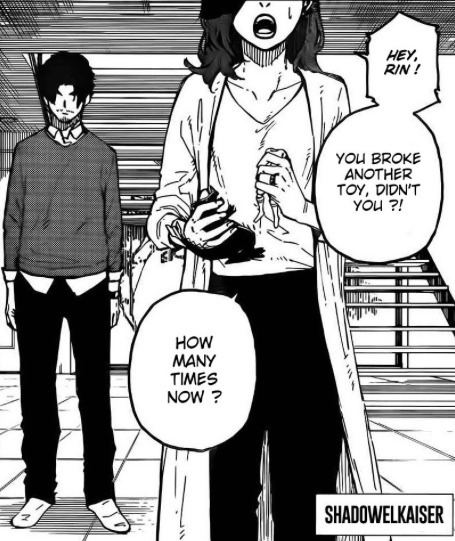
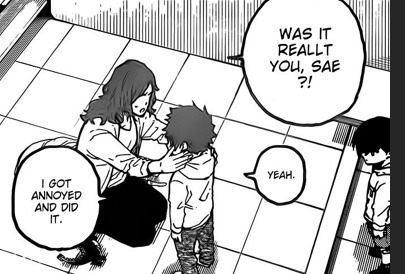

evidently, itoshi mom is a very concerned mother: she doubts herself, she worries for rin (and sae), and she’s generally lost.
and how could she not feel all those things?
i perceive this as she’s a mother who doesn’t distance herself from her children, but because she doesn’t know what to do at all, she seems hopeless and doesn’t have any solution to fix things. naturally, she has the instinct to do what a parent should in times like scolding, etc—however, this is blue lock, everyone has their own ‘ego’, yet some of those inner desires are just cultivated beyond rationality at this point.
(which strengthens my suspicion about the itoshi parents unconsciously putting the responsibility of rin’s behavior onto sae…)
now, itoshi dad
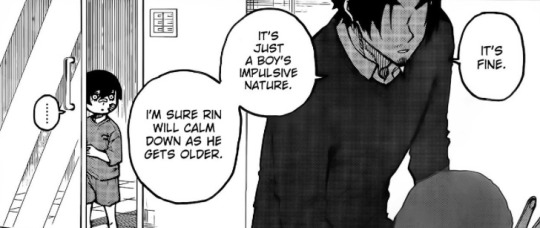
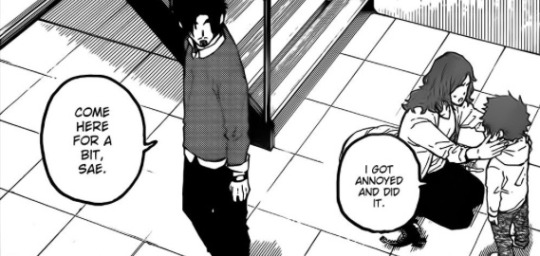
honestly, i don’t have much to say about him, he’s pretty hands off with what’s happening with their children.
as seen, he does seem more composed and lax about everything, and sae definitely got that from him. i wonder if it’s because of itoshi dad’s ‘talks’ (?) with sae that somewhat developed sae to be the big brother he was to rin back when they were little.
i believe the narrative is just implying that he doesn’t think much of the behavioral differences that rin and sae show, even when rin gets injured and gets in trouble, which is a little yikes on his end but that’s just what i understood.
most definitely, the siblings got the trait of being closed off from their dad, lol.
overall, i still don’t believe they’re bad parents whatsoever. however, i do want to talk about my recurring theory that the itoshi parents gradually placed the responsibility of rin’s behavior (and his whole development) onto sae.
let’s discuss the impact of itoshi sae

when sae was around 13-14, he went to spain, and during the pre-teen/teenage years of the itoshi brothers, their family seems rather peaceful.
the itoshi parents—aside from the pride and joy they felt about sae’s success as a rising soccer player—seem rather refreshed, anew, and just happier. they don’t carry the gloom of being worried for their children’s behavior anymore.
but why?
it’s because of rin and sae’s bond over soccer. from a young age, rin has joined his big brother’s soccer team as they both relished the games they could never play with anyone else aside from each other. basically, the itoshi brothers found what they were for. and they definitely got occupied over it.
though i’m only connecting the dots for my own analysis, i firmly believe that the moment rin played soccer with sae, he found a way for his destructive mindset to be utilized. through soccer—the only thing rin has been focusing on—rin was able to effectively let out his desire to break, destroy, and kill what’s “amazing/perfect”.
and who was the only one there by his side, every pass after pass and goal after goal? of course, it’s his big brother. the one to only truly understand and see rin from the very beginning.
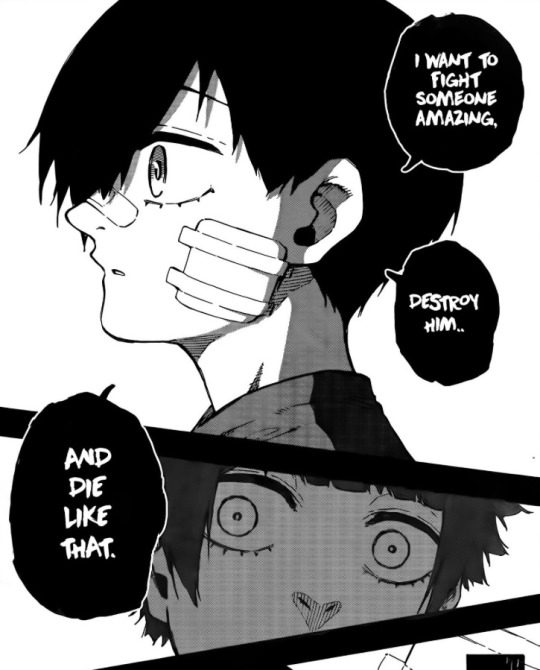
honestly, it all makes me wonder if the itoshi parents ever talked to sae one-on-one about rin’s behavior. (which honestly makes sense, because sae seems like a pretty obedient kid). but at the same time, what are the chances it made sae extremely analytical, too?
i mean, sae was deemed a prodigy at what 7 years old? that’s seriously insane. so it shouldn’t be a surprise that all of what’s leading up to the ego of the itoshi siblings plays a big part. i’m leaning on the possibility that sae was somehow influenced by the itoshi parents to be more keen or observant on rin—that or sae was only doing what he did out of pure instinct, that’s entirely plausible.
however, whatever the course may be, the outcome that sae noticed something with rin (even before their ego in soccer) will not change.
from this point onwards is just my random babbles about the itoshi family’s relationship (kind of…)
“but when sae left for spain the itoshi parents didn’t appear to care about rin-” i am not hearing that. we should remember that blue lock is (honestly borderline but whatever) about SOCCER.
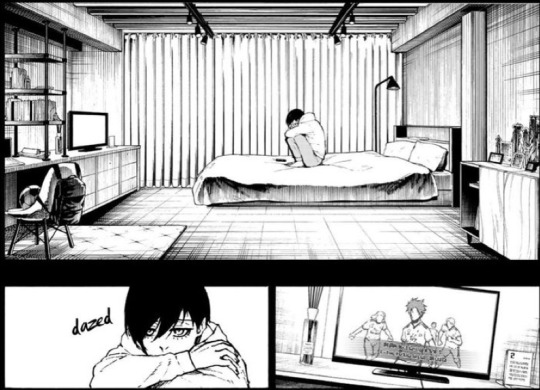
i believe the first ever backstory we got of the itoshi siblings was only soccer-centered, and in rin’s perspective/narration. why would his parents be included in his soccer career when they most definitely weren’t?
again, i don’t believe that they’re bad parents.
also, i doubt that itoshi mom would ever just stop worrying about rin, even when he’s grown up! in fact, i think that with sae leaving for spain, she probably felt even worried because their children are separated. yet at the same time, i do see her not knowing what to really do again. perhaps they had no cameo after the airport scene because rin found it irrelevant in regards to soccer and his ego.
but, then again, i’m very certain that the itoshi parents do care for their children, and are still connected to them somehow…just not when it comes to the field.
aside from the second backstory (the most recent one) they look out for them (i assume this goes for rin too). in the character book the egoist bible, sae mentioned how his parents send him salted kelp from home to go with his rice when he asks. additionally, we saw itoshi dad say in their first back story for sae to “take care of your health!” as he leaves for spain. the itoshi parents do seem to care for rin and sae as supportive parents of athletes, however, only in the sidelines, because i personally don’t think it goes deeper than that.

honestly, everything for me is pointing that the itoshi parents aren’t active and present in the itoshi brothers’ soccer careers. not necessarily implied, but in the ‘another blue lock: episode omotesando’, rin is the only one seen that has a ticket to sae’s japan triumphant match. a ticket sae sent—of which i assume—only to him.
although this is all still just my speculation, i am still leaning on that the itoshi parents aren’t really relevant in the itoshi siblings’ soccer life, but rather, they play a role in how they ended up developing.
that’s all!
again, this are just my own thoughts about this chapter. this is not canon by any means and i am not forcefully saying what i am discussing is right and should be deemed the only theory/ies out there.
i’d love to talk more about theories and analyses on blue lock, let’s chat!
#blue lock#blue lock manga#itoshi rin#itoshi sae#sae itoshi#itoshi brothers#itoshi siblings#rin itoshi#rin#sae#blue lock 271#bllk#bllk manga#itoshi parents#itoshi
403 notes
·
View notes
Note
I disagree that a sequel is necessary. While I see the potential for new storylines, the idea of introducing a completely new set of antagonists doesn’t appeal to me. Starting from scratch with villains can feel like a major challenge, and bringing back old ones would only lessen the impact of their original arcs. I don’t want to see previous antagonists resurrected, as it would feel forced and undermine the emotional weight of their defeats.
There's also the power vacuum left by the deaths of major characters, but that doesn’t automatically mean the story needs to continue. Sometimes, the best choice is to let things end naturally rather than create a new threat just to keep the series going.
Jujutsu Kaisen's ending might not be saved by a sequel. If Gege is tired of the universe, it could show in the quality of the continuation. Forcing a sequel when the creator might not be fully invested could result in something lackluster, and I’d hate to see the series lose what made it great in the first place. I also feel strongly about the need for Gege to rest, especially with the health concerns and breaks he had.
I prefer complete, well-rounded stories, and I’m concerned that a sequel would compromise that. In the end, I just don’t want a sequel to happen, as I believe Jujutsu Kaisen could have ended on a stronger note without needing to push the story further.
About the villains: would you say Sukuna's and Kenjaku's arcs are completely finished? Have they been used to their full potential?
Kenjaku eg. has a background connection with Yuji but no actual relationship with him in-story. There is no push and pull between those two and their past hasn't been dealt with either. Kenjaku also has no realtionship with Nobara and Megumi and only a small one with Gojo. As a villain he did much but his interpersonal connections were severly lacking except for Choso which was one-sided.
A potential sequel could present us the relationship and history with Kenjaku and Yuji that hadn't been dugged into until now. Not to forget Heian era history.
For Sukuna its a bit more complex. He had a deep relationship with Yuji and build one with Gojo during their fight. He showed a different side to him through his relationship with Uraume. But what was extremely missing and cut out in the end was a relationship with Megumi. Megumi's end to his own arc was also cut out.
In a potential JJK 2, Megumi dealing with Sukuna (in whatever form he would appear, a curse or trauma) would delve into that missing part of JJK which had existed since the Cursed Womb arc. What would also come from there is Sukuna's past and why he agreed to become cursed objects in the first place.
As a personal opinion, I would like new desaster curses eg a Death Curse. That would bring that curse-centred feeling back to JJK that was missing since Shibuya.
And of course, I wouldn't want a sequel that isn't made with passion either. If Gege has no desire or love for more stories of JJK (outside of maybe small chapters or light novels) than he shouldn't be forced to continue it. If he has health problems that's the same thing.
But just like me who simply assumes that Gege would love to continue the story, you assume that he wouldn't. But in reality we can't tell in any way what Gege thinks about this and if he even has a potentially bad health status. We get small glimpses of him, which is standard for mangaka, and there isn't much to go from there.
He said recently that he's happy the story ends. Yes, JJK will end with chapter 271. That's a statement of fact and can't necessarily be used to say a Part 2 won't come. In the past, sequel anouncements also took months if not years. We can't tell.
What I wanted to say at the end is, I don't think JJK is a well-rounded story. As it stands now, it has superflous plot elements that should've been trimmed down to make it a well-rounded story. Instead we had last chapter were we went through the fat so to speak and cut it off after the meat has already been cooked.
(Please don't roast me for my metaphor, I hate cooking)
There is a reason why "JJK Part 2" is a popular theory/demand and that's because there is room for one that most people have no problem seeing. I don't think that BHA and Demon Slayer had such big Part 2 feelings outside of a niche demand which always exists with all manga and anime that end.
So I don't think JJK would be pushed into more stories. I think it has the groundwork to build those naturally from everything the story has presented us during its run.
10 notes
·
View notes
Photo

New Post has been published on http://drubbler.com/2017/02/24/latest-tips-of-soviet-power/
Latest tips of Soviet power
(adsbygoogle = window.adsbygoogle || []).push();
Polina yakovleva, February 24, 2017, 22:12- REGNUM
Hospital “presidential housing. “The main country here has its own Chamber. Cozy, almost home atmosphere. Here, in one of the rooms, have a ballot. 73-year-old General Secretary Konstantin Chernenko is currently declining to “polling station” in a wheelchair. His assistants will remember how hard he was given these “performances”. This time he is terminally ill, meets with the force and rises to meet Protocol obligations.
the Soviet tv receives picture voting Secretary 1 .
two weeks later, He dies. It will be the last Soviet leader, upokoennym near the Kremlin wall.
at the launch of “flywheel” global changes will need 65 days.
11 March by the Secretary-General of the CENTRAL COMMITTEE of the CPSU Mikhail Gorbachev will become.
April 23 at the plenum will be announced beginning of acceleration policy… “ 2, 3
in the middle of may, during a meeting with activists of the Leningrad city, Gorbachev says his famous” rebuilt “ 4 .
but all that happened later. February 24, 1985 years the country has elected Supreme Soviets Union and autonomous republics, as well as local councils of people’s deputies. The habitual constituencies elections under the command of the COMMUNIST PARTY. That this is the last campaign in this format might, then, is that we in a bad dream on Sunday.
simple slowdown
“go funeral Secretary General. Citizen tries to break closer to the mourning procession. His KGB officers stopped and asked:
— you have an invitation?
— no, I pass! ”
almost a year before Constantine Chernenko, in February 1984, Yuri Andropov died in November 1982 year-Leonid Brezhnev.
Society to a series of “funeral” the Kremlin concerned already calm and politically correct. As there, Leonid Filatov? “Act strictly according to the law — that is, Act … sneaking. The reaction was “kitchen” jokes, which perfectly convey the mood of the people.
a country bursting with events and lived under “Advanced socialism”. Because alternative statements from high tribunes until it was 6. 271 million. man (18 million of which are in the 5 ) read the editorials of newspapers about the growth of economic potential, income and professional successes — Rezhskogo nickel plant workers fighting for the early tasks of the five-year plan, assumed the counterplan and advanced Socialist obligations … ”
Committee on Statistics predicted that national wealth in 1987 year will nearly 50 times in comparison with the year 1913.
However, not all okay in the Soviet State. The collection of statistics did not include an exhaustive “arms race” and the Afghan war, international economic and scientific-technical insulation USSR, strained relations with the largest communist neighbour China, the effects of the political crisis in Poland, the beginning of the 80 ‘s dissident movement, though and could be divided into “Westernizers” and the “Slavophiles”, merged in unison remove power from the Communist Party.
growth, turning into the overall drop, do not justify its name 6 .
many today blamed the economy as the reason for the collapse of the country. However, not all problems lead to a systemic crisis, and not every systemic crisis is destroying the State system.
“stagnant phenomena” in the Soviet economy of that period in the 27th Congress of the CPSU Mikhail Gorbachev speaks. For others, it was a time of stability. “As the State Planning Commission and 20 years ahead of scheduled” — lived the majority of Soviet citizens. Estimated, planned. Including participation in elections. Voluntary-compulsory. And, in fact, the turnout was such that captures the spirit of almost 100%. Yes there is talk in April weekends dedicated to the day of the birth of Lenin, collectively Meli, painted voroshili, melted snow 160 million people.
the basic law. Childhood, adolescence, youth
here is already 8 years the USSR lived and chose the new “vneklassovoj” of the Constitution.
the election of the first years of Soviet power, universal and secret. Voting rights were denied the “exploiters” (those who used hired labor), private traders, priests, former police officers and a number of other categories of the population 7 . The year 1936 Constitution declared the USSR State workers and peasants “. The Basic Law of 1977 year — already in the preamble commits suicide “dictatorship of the proletariat” in favor of “shhenarodnogo State”.
“a new historical community of people — the Soviet people” exercised State power through the Councils of people’s deputies 8 .
to elect and to be elected at the Supreme (Tips … USSR, Soviet republics, autonomous republics), as well as in the local hierarchy which picture of the status of the administrative-territorial unit. Paramount, along with regional, regional councils of people’s deputies, the Councils of people’s deputies of the autonomous communities and autonomous okrugs, regional, city, district, located in urban and rural councils of people’s deputies — constituted a unified system of public authorities 8 . Supreme Soviets were chosen for 5 years, local councils of people’s Deputies is at 2.5 years.
“leading and guiding force of the Soviet society, the nucleus of its political system, Government and public organisations was the COMMUNIST PARTY 8 .
Apply voice
who in 1984 year voted the first Communist country, “Konstantin Chernenko? Like all — for the only candidate “in place” that was in his bulletin. Agreed that the Secretary General of the party, and led.
how and when Soviet citizens vote explained numerous polygraph. products, media and agitators.
At the first Soviet election turnout at stations was small 7 and propaganda network grew over the years. For example, Molotovskoj (now Perm) oblast by the 1947 year 43 thousand were recruited. agitators on elections (one in ten courtyards, one to 25 − 30 9 ).
it was important to explain and more — who are voting. The first time (that was not yet a habit) is why, actually, for one. The Chairman of the District Commission Kalagaev commented: “we must tell the voters, and even some fellow starts to appear questionable, how do you vote for one. Some thought that the vote must be for 10 − 15 people. This does not necessarily, not told. You understand that we will have a great deal of advocacy on this issue. ” The explanation proposed is: “the other candidates don’t have, because we do not nominate them for our County areas” 7 explained he leadership of the precinct election commissions Gor’kovsko-Leninsky district.
to elections was taken to walk early, do not tighten until the evening. And here in the early morning (often prior to the opening of polling stations) people ran in the elections. This symbol of the emancipation of the working class, eventually evolved into the procedure. In duty. However, pleasant.
more than 99.99% of voters came to the polling stations on February 24 (99.97%)- 15 . Working from 6 am until 10 pm, they smelled fresh pastries, there were music and human gvaltom. Somewhere a clear rhythm dancers struck — master of amateur performances. People were elated.
Polling booths for secret expression “were located in a separate room and were proven over the years a sample” ergonomic design “: two prefabricated plywood shield 2 x 1.6 meters x 1.2 meter. Front cabin was closed curtains. Top remained open. 7
the wooden ballot boxes for the vote, too, fit into the Interior. There is a version that the CPSU (b) back in November 1936, entered into correspondence about purchase “electronic ballot boxes. Negotiations were conducted with the American firm “Omatig Woutng korporeichen” thing, which was the sole producer of machines for voting. But the deal never took place. «Authentic» wooden ballot boxes and voting booths have remained in the country for decades.
elections for many years went by the same scenario.
in the local councils, the Parliament, by the first past the post system, i.e. the majority, chose one member. In the Supreme Soviet of the USSR could pick two, but also “one at a time — in the Union Council and the Council of nationalities.
To vote against, had to do more. And rather moral than physical. Vote “Yes” — you get the newsletter and opuskaesh’ in the URN. Vs-vycherkivaesh’ candidate.
the official results showed that the “against” votes less than 1% of voters. As the saying goes, within the statistical margin of error.
on the ballot — leaders and party elite. Legislative norms do not have representation of women, workers, farmers, non-party and the Communists. However, the recommendation of the Party (including Lenin principle of involving women in governance) and still the same chapter 6 of the Constitution on equality of citizens strictly observed and constitute important features of the Soviet electoral system.
consisting of elected deputies (USSR): 35.2% and 16.1%, 4.5% of farmers to managers; workers party organizations — 16.7%, State and Soviet authorities — 13.2%; 64.7% of men and 35.3 percent of women; youth up to 30 years is 22%.
in 1985, massively and amicably — all to the Supreme Soviets of the Union republics chose 6.730 man:
975 per person. — in the Supreme Soviet of the Russian SFSR,
650 persons. -in the Ukrainian SSR,
485 people. -in Byelorussian SSR,
510 persons. — in the Uzbek SSR, the same is in the Kazakh SSR,
440 persons. — in the Georgian SSR,
-450 in the Azerbaijan SSR,
for the 350 is in Lithuanian, Kyrgyz, Tajik SSR,
340 persons. — in the Armenian SSR,
-380 in the Moldavian Soviet Socialist Republic,
330 Pax. — in the Turkmen Soviet Socialist Republic,
325 people. — in Latvian SSR,
and 285 people. — in Estonian SSR.
to the Supreme Soviets of the autonomous republics elected deputies:
the Bashkir Autonomous Soviet Socialist Republic is 280 persons,
Buryat — 170 Pax.,
Dagestan — 210 persons,
Kabardino-Balkar ASSR — 160 Pax.,
Kalmyk — 130 Pax.,
Karelian ASSR-150 Pax.,
Komi-180 Pax.,
Mari-150 Pax.,
Komi-175 persons,
North-Ossetian-150 Pax.
the Tatar-250 Pax.,
Tuva — 130 Pax.,
the Udmurt-200 Pax.,
Chechen-Inga (adsbygoogle = window.adsbygoogle || []).push();
0 notes
Text
Book II
In book 1 of the Quintilian, the argument was based around the children. In book II, the discussion switches to the teacher. The main issue that I had with book 1 was in regards to Quintilian not focusing, or even really caring, about what the student wants. Another similar issue comes up in book II. Kamaria, writes her blog very well about his topic. In chapter 8, Quintilian writes about how teachers should understand what each student is best at, and steer him in the direction that best suites him. This argument seems to work for students who, according to Quintilian, are smart enough to find the profession that best works for them. Examples that he writes about include the court for people best suited for law and history for students who are fascinated with that subject. But, some students undeniably have weaker talents in regards to oration. These students should be cautioned from trying subjects or disciplines that would be impossible for them. In fact, it may be easier for them to be, “sent home to the farm.” (319) I don’t believe that Quintilian necessarily means this in a bad way. Just like there are some kids who may not benefit or find satisfaction with a college degree today, there are kids who would be better suited for farm work or Manuel labor. There is nothing wrong with that. I believe that is part of the argument that Quintilian is making in chapter 8.
Another aspect of book II I want to note is Quintilian’s knowledge of how teachers should deal with students. One quote I really enjoyed was in chapter 3. He writes that teachers, “must not be given to anger, but he must not turn a blind eye to things that need correction; he must be straightforward in his teaching, willing to work, persistent but not obsessive.” (271) I’m sure students have noted this thought or quote before, but I was struck by how Quintilian has a wealth of understanding in regards to teaching kids.
0 notes